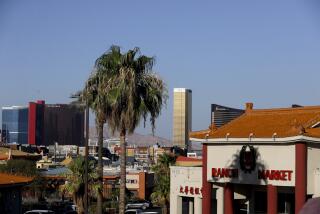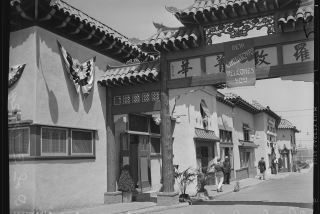Church Spans Culture of Chinese-Americans
When asked to translate “I got wonderful vibes” into Chinese during a trilingual church service Sunday, Elder Samuel Cheung was at a loss for words.
Church members, representing three congregations attending a joint service of the Chinese Christian Alliance Church in Canoga Park, laughed good-naturedly, sympathizing with Cheung’s predicament. The members, the majority of whom are Chinese, knew only too well how frustrating it is to struggle for the right expression in a second language.
On any other Sunday, the church avoids such communication difficulties by offering three separate services, each given by a different pastor in a different language--English, Mandarin Chinese and Cantonese Chinese.
New Northridge Site
But all three congregations gathered Sunday to celebrate the church’s 10th anniversary, and to help dedicate a new church site on Roscoe Boulevard in Northridge.
The church was the first Chinese-American church in the San Fernando Valley. Its membership has grown from 25 in 1976 to more than 250 today. Church leaders attribute their success to a willingness to accommodate the Valley’s diverse Chinese population.
Ten years ago, there were an estimated 500 Chinese families in the Valley. Now, there are about five times that number, said Ken Au, an aerospace engineer and third-generation Chinese-American who was one of the church’s founding members.
For some, attending a Chinese-American church is one way of exposing their American-born children to Chinese culture.
“My father did it for me, and I feel I have to do it for my children,” said Ronald Lew, a Los Angeles Superior Court judge who is a first-generation Chinese-American.
Culture Important
Shirley Moy, a 26-year-old real estate agent who grew up in a middle-class neighborhood in New York, also believes that exposing her children to Chinese culture is important.
“For a long time I didn’t know that other people ate with chopsticks,” Moy said. “Children need to know that they are not different, that it’s OK to be Chinese.”
Unlike many of the estimated 400 other Chinese churches in the United States, the Chinese Christian Alliance Church was started by American-born Chinese for American-born Chinese, according to senior pastor John Ng. “Most of the Chinese churches in the United States are transplanted churches from overseas,” he said.
Moy, who was born in this country, said that in other Chinese churches she has attended, services were tailored for Chinese immigrants rather than the American-born Chinese.
“I felt that we were taking a back seat to the overseas-born,” Moy said.
But church leaders quickly recognized a need also to serve Cantonese and Mandarin-speaking immigrants--40,000 of whom immigrate to the United States each year.
Fills Gaps
In addition to overcoming the language barrier, such multiple-language services sidestep cultural and generation gaps between church members. For example, each congregation prefers a different mode of worship, said Patrick Tsang, pastor for the church’s Cantonese congregation. The English-speaking and predominantly American-born congregation enjoys guitar music and contemporary hymns in its service, while the Cantonese congregation never uses them, he said.
When people address the Cantonese pastor, they never call him by his first name, Ng said. They call him Pastor Tsang, or pastor, he said. “Most of the people in my congregation call me John,” Ng said.
More to Read
Sign up for Essential California
The most important California stories and recommendations in your inbox every morning.
You may occasionally receive promotional content from the Los Angeles Times.










